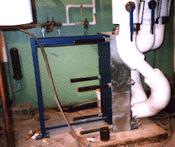Winner Elementary, Winner South Dakota
Installed 1996
Owner: City of Winner
Building Size New Addition: 44,000 sq/ft
Number of tons: 81 tons
Average Bill: Had not run a full year at the time of publication.

"The only regret we have with the system is that we only used
it on the new addition and not the entire school", Mike Elsberry, Superintendent
Winner School District.
Winner Elementary School added a new 44,000-sq-ft building for the start of the 1996-97
school year. The Energy Miser system was selected to provide 81 tons of heating and
cooling.
The system's municipal water loop circulates water from the main, through a plate-frame
heat exchanger in the mechanical room, and back to the main. The building water loop
circulates water from the heat exchanger to 16 Energy Miser units, ranging in capacity
from 2.5 to 9 tons, located throughout the structure. 
Installed in the ductwork, the units perform refrigerant compression and distribute
heated (or cooled) air within the building. In the zone each unit handles two classrooms,
enabling teachers to a control their own environment,".
The old part of the school uses a boiler system that puts the whole building in heating
or cooling mode. While some sections of the school are comfortable, others may be cooler
or warmer. With the zoned approach, "We hear the same comment from all our customers:
' The building is much more comfortable than ever before,' ".

During milder weather, the municipal water loop may not even be needed by the system.
The building loop needs to reach a low temperature of 55 deg. F or a high temperature of
80 deg. F before the municipal loop begins to circulate water. If the temperature is
inside the above range, the building loop redistributes Btu within the addition. During
the extremes of winter or summer, the municipal water circulates at a maximum of 250 gpm.
"Even at that rate we only see a 4 degree drop in the municipal water temperature
through the heat exchanger, or a 4 degree rise in the air conditioning mode," says
DeMarco. "Our research shows that change in temperature is immediately dissipated
upon reinjection into the municipal water main."
Once again we expect a 50% reduction in the cost per square foot compared to the
existing site.
